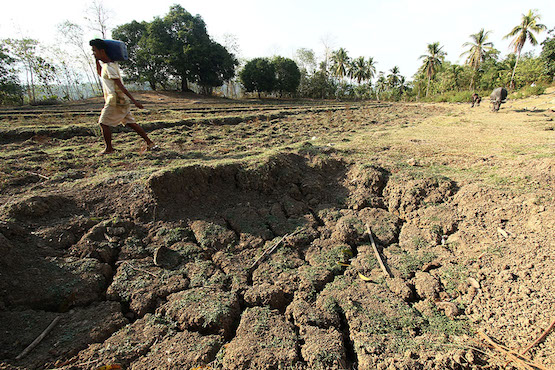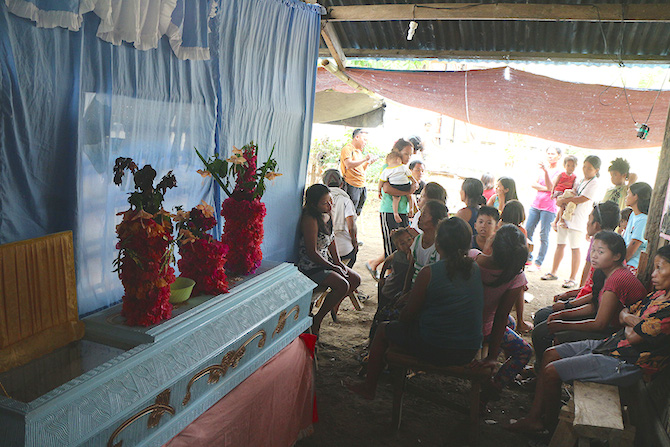Drought takes a terrible toll on poor Filipino farmers
April 11, 2016 ·
Worst dry spell in years is forcing rural folk to take desperate measures

A farmer walks by a parched pond in a remote village in Libungan, North Cotabato. The province is one of the most heavily affected by El Niño damaging thousands of hectares of agricultural land. KEITH BACONGCO
Swathes of corn stand withered on the parched rolling hills near the farming town of Arakan in the southern Philippines, while shallow cracks scar what were once fertile rice paddies.
El Nino is wreaking havoc in agriculture-rich Cotabato province.
Allan Salon, a member of the Manuvu tribe, says life is hard these days. There is nothing to harvest and hunger is rife.
In the village of Malibatuan, people only eat once a day with the children getting most of what there is to eat.
Desperation and hunger forced Allan and his brother, Lito, to join their neighbors, in heading to the provincial capital, Kidapawan, on March 29. The village leader said everyone who went to the city would get a sack of rice.
Allan and Lito believed that they would return home that same afternoon with their bags of rice.
“I was told we would be going joining a ‘picket,'” said Allan. “But I did not know what that meant.”
“We went because we were told the governor give a sack of rice to each of us,” he said.
They, along with 6,000 other poor and hungry farmers and tribal people, gathered and blocked a major highway linking the Cotabato and Davao provinces in Mindanao.
At least three people were reported killed when police moved in to break up the highway blockade on April 1.
The state’s Commission on Human Rights identified at least two of the victims — Enrico Fabligar, a bystander from Kidapawan, and Darwin Sulang, a farmer from Arakan.
Sulang’s friend, who asked not to be named, says they also went to Kidapawan thinking they were going to collect rice.
Lito also didn’t make it home. After sleeping rough for several days, Lito complained of back pains and a headache. On the evening of April 3, Lito was rushed to hospital in the neighboring town of Antipas where he died.
Lito’s wife, Margarita, says her husband died from heat stroke.

Relatives and neighbors attend the wake of Manobo farmer Lito Salon at their house in Brgy Malibatuan, Arakan, North Cotabato on Tuesday, April 5. Allan, Lito’s brother said they went to Kidapawan March 29, thinking they would get a sack of rice each. They returned home March 31, a day before the violent dispersal, after Lito complained of headache and back pains. Lito’s wife Margarita said her husband was rushed to the Antipas District hospital on April 3 and died on April 4. KEITH BACONGCO
Help is needed
According to activists the blockade was a desperate cry for help from farmers enduring one of the worst droughts on record.
International aid agency Oxfam says the Philippine government needs to immediately provide “adequate food and livelihood assistance” to farmers suffering from the ongoing drought in the southern part of the country.
“In times of crisis, the most vulnerable must be supported and protected,” says Oxfam’s Jermaine Bayas.
The vulnerable also includes Melody Ababon who has to gather banana stalks near her home in the town of Kibungan to feed her cow.
The animals have nothing else to eat, she says. “The fields are dry, and the bananas are slowly going too.”
Before the dry spell, her cow was fat, Melody says. Now, the ribs are showing. “Some farmers have already sold their farm animals to buy food,” she says.
In the town of Pigcawayan, Nonoy Domaguit, says he already sold a pair of goats because the animals have nothing to eat.
“I did not want to sell them, but I pitied them because they have nothing to eat,” he said.
Worst is yet to come
There are thousands of similar stories from farmers of scarce water, crop failures and starving land dying livestock in the southern Philippines.
At least 135,000 families are affected across the country by the drought, 95 percent are in Mindanao.
The United Nations last year warned that the El Nino phenomenon this year would bring prolonged dry spells on par with those caused by the same phenomenon that occurred in1997, which was considered the strongest in 50 years of accurate data gathering.
In the Philippines, it reduced rainfall by half and agricultural production by almost eight percent. It seriously affected 74,000 hectares of agricultural land in 18 provinces.
Bureau of Agricultural Statistics data show that the volume of rice production fell by 24 percent and corn, 12 percent, in 1997-98.
The impact was most felt in Mindanao. More than 74 people died and almost half a million agricultural families starved because of the drought. Shortage of potable water was also reported.
These figures serve as a bad omen for the farmers of 2016.
Jerry, a farmer in Antipas saw his usual crop of rice slashed from 300 sacks to 70 last month. He is well aware of what happened in 1997 and is worried.
“It seems that the worse is still to come,” he says.






